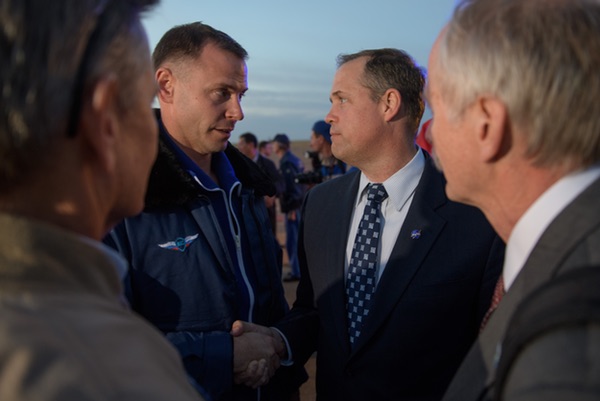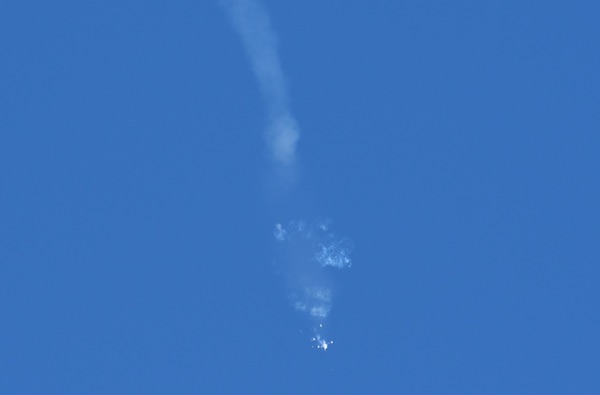A fraying spaceflight infrastructureby Jeff Foust
|
| But, if you had to depend on a single vehicle to get to the station, the Soyuz would be a good choice. Until last Thursday, that is. |
That sounds good in theory, but NASA and other space agencies have not been able to consistently implement it. Cargo resupply of the International Space Station is one example where it does work: the failure of an individual supply vehicle does not jeopardize the station since other vehicles, developed by other agencies or companies and launched on other rockets, can pick up the slack—critical since Cygnus, Dragon, and Progress vehicles have all suffered launch failures in recent years.
That hasn’t been the case, though, for human spaceflight. Since the retirement of the Space Shuttle seven years ago, the ISS partners have relied exclusively on the Soyuz spacecraft for getting people to and from the station. That was intended to be a temporary situation, although it has stretched on for much longer than originally planned given delays in the development of commercial crew vehicles.
But, if you had to depend on a single vehicle to get to the station, the Soyuz would be a good choice. The spacecraft and its eponymous launch vehicle have decades of experience and, after two accidents early in its flight history that killed four cosmonauts, had a sterling record.
Until last Thursday, that is. On a clear fall afternoon in Kazakhstan, the Soyuz rocket carrying the Soyuz MS-10 spacecraft lifted off from the Baikonur Cosmodrome. On board were NASA astronaut Nick Hague and Roscosmos cosmonaut Alexey Ovchinin. Had all gone according to plan, the spacecraft would have docked with the station six hours after launch, with Hague and Ovchinin joining the three already on the station for a six-month stay.
Two minutes after liftoff, something went wrong with the Soyuz rocket, though. Exactly what remains the focus of the ongoing investigation, but speculation has focused on a problem during the separation of the four side boosters.
“Watching the ascent from our contingency action center here, the first stage appeared nominal,” said Reid Wiseman, NASA deputy chief astronaut, during a news conference several hours after the accident. “There was first stage booster separation and then the abort occurred, and that’s really all the data that we have at this time.”
“There was a deviation from nominal trajectory, and damage to the lower part of the second stage,” said Sergei Krikalev, the former cosmonaut who currently serves as director of manned spaceflight at Roscosmos, told reporters Friday in the latest official update into the investigation of the failure.
Whatever the cause, the problem triggered the Soyuz spacecraft’s abort system, pulling the spacecraft away from the rocket. The spacecraft performed a ballistic reentry and landed near the town of Zhezkazgan, Kazakhastan. After some tense moments, including lack of communications with the capsule during its descent that triggered unpleasant memories of Columbia, Roscosmos reported that search and rescue teams had found the capsule and reported Hague and Ovchinin were well. A few hours after launch, they were back at Baikonur, reunited with their families.
With the immediate concerns about the well-being of the crew resolved, the questions now turn to the implications to the Soyuz failure for the station and other programs. With the Soyuz grounded for some period of time, it leaves the ISS partners without a means of getting a crew to the station. The three people currently on the station— Alexander Gerst of ESA, Serena Auñón-Chancellor of NASA, and Sergey Prokopyev of Roscosmos—have a Soyuz docked to the station for a ride home, but that Soyuz is certified for only about 200 days in space. Since that Soyuz MS-09 spacecraft launched in early June, that 200-day period will run out in late December.
| “We’re going to look at what our options are to try to make sure we don’t have to de-crew station,” said Todd. |
That on-orbit lifetime could be stretched out a little bit, but not much. “There’s a little bit of margin” on that lifetime, said Kenny Todd, NASA ISS operations integration manager, at a briefing Thursday, “but not a whole lot of margin.” The Soyuz would likely reach the end of life by early January, he indicated.
If the Soyuz launch vehicle problem isn’t resolved by then, NASA and the other partners have a few choices. One is to see if the Soyuz on-orbit lifetime can be stretched out. A second could be to launch an uncrewed Soyuz spacecraft to the station, making an automated docking and providing the station’s crew with a “fresh” spacecraft to extend their stay.
In either scenario, it would mean extending the stay of the crew beyond their planned six months. “I talked to the crew this morning. They’re doing great,” Wiseman said. “They’re ready to serve at the will of the program. They will stay up there as long as we need them to.”
A third option would be to have the crew come back in the Soyuz at the station, leaving the station unoccupied for the first time since 2000. Todd said he believed that doing so would be feasible, at least for a limited time.
“I feel very confident that we could fly for a significant amount of time” without a crew, he said. “There’s nothing that says we can’t just continue to bore holes in the sky and do a minimal amount of commanding. I’m not too concerned about that.”
However, a problem on the station during that time, without a crew on board to correct it, could jeopardize the facility’s future. Todd suggested “de-crewing” the station would be an option of last resort. “We’re going to look at what our options are to try to make sure we don’t have to de-crew station.”
Russian officials have indicated their investigation will be a fast one, with Krikalev promising on Friday to have initial results as soon as October 20. According to one Russian media report, the next mission to the station, which was scheduled for mid-December, could be moved up to as early as November 28.
 Astronaut Nick Hague (left) shakes hands with NASA administrator Jim Bridenstine after last Thursday’s abort. (credit: NASA/Bill Ingalls) |
That haste, though, contrasts with the slow pace of another investigation, that of the hole found in the Soyuz MS-09 orbital module in late August. A week and a half before the launch accident, Russian officials at the International Astronautical Congress in Germany offered no updates on the status of that investigation, saying only that they would provide their findings in mid-November, two and a half months after the hole was found, and patched, in the spacecraft. (That schedule was based in part on plans for a Russian spacewalk in early November to investigate the hole from the outside, a spacewalk that has been cancelled in the wake of last week’s accident.)
| While Russian space efforts have suffered a number of failures from manufacturing or operational problems, the human spaceflight program has appeared largely immune from those quality control issues. These incidents suggest that may no longer be the case. |
That earlier incident with the Soyuz spacecraft aggravated tensions between the U.S. and Russia in space, particularly after reports in Russian media claiming that the hole was created deliberately by American astronauts on the station who, for some reason, wanted to leave the station early. Outside Russia, most suspect the hole was a defect created during manufacturing or launch processing.
A new round of Russian reports, prompted by comments made on Russian television by the head of Roscosmos, Dmitry Rogozin, that the hole was made deliberately led to a statement from NASA October 3. “Ruling out a manufacturing defect indicates that this is an isolated issue which does not categorically affect future production,” NASA said. “This conclusion does not necessarily mean the hole was created intentionally or with mal-intent.”
However, that incident, and the Soyuz launch failure last week, point to a potential systemic problem larger than an individual manufacturing defect. While Russian space efforts have suffered a number of failures from manufacturing or operational problems, from a Proton that turned and flew into the ground because of improperly installed gyroscopes to a Progress launch that failed because of incorrect solder used in an upper stage engine, the human spaceflight program has appeared largely immune from those quality control issues. These incidents suggest that may no longer be the case, with implications that go beyond the investigations into these missions.
The ISS partners, though, may have little choice but to go ahead with Russia’s plans for resuming Soyuz flights, since there are no other options for accessing the station. While NASA once hoped Boeing’s CST-100 Starliner and SpaceX’s Crew Dragon would be in service by now, those vehicles are still in development with oft-delayed test schedules.
A week before the Soyuz accident, NASA released an updated schedule for commercial crew test flights. SpaceX’s uncrewed test flight, previously scheduled for November, had slipped to January, while its crewed test flight had moved from April to June: a delay of two months from the previous schedule, which had been released two months earlier. Boeing’s flights had also shifted, to March for the uncrewed test and August for the crewed test.
By coincidence, NASA’s Aerospace Safety Advisory Panel held its latest quarterly meeting last Thursday, just hours after the Soyuz accident. While the committee could say little about the accident itself, members were worried it could put pressure to accelerate commercial crew vehicle development, at the risk of safety.
“The panel believes that an overconstrained schedule, driven by any real or perceived gap in astronaut transport to the International Space Station and possibly exacerbated by this morning’s events, poses a danger that sound engineering design solutions could be superseded, critical program content could be delayed or deleted, and decisions of ‘good enough to proceed’ could be made on insufficient data,” said the panel’s chair, Patricia Sanders.
Much of the meeting went into the technical issues that made the panel skeptical that made even the revised schedules appear unachievable for the panel. For SpaceX, that included ongoing studies of the composite-overwrapped pressure vessels, whose failure caused the pad explosion of a Falcon 9 more than two years ago, as well as unspecified issues with parachutes. Boeing’s issues included its own problems with parachutes as well as a problem found during a hotfire test of the engines in the spacecraft’s service module this summer.
| “The question is whether there’s a way you can compress that schedule,” said Reed. “You don’t look at it in terms of cutting out work.” |
It’s not clear that speeding up commercial crew development is even feasible, though. Executives of Boeing and SpaceX, speaking at the International Symposium for Personal and Commercial Spaceflight in New Mexico last week, emphasized they wouldn’t cut corners to speed up development.
“We look at it in terms of, ‘Could I work extra shifts or put extra people on it?’” said John Mulholland, vice president and program manager for commercial programs at Boeing’s space exploration unit, when asked if accelerating development schedules was an option. “It never crossed our mind to think what could you not do, what scope can you reduce.”
“You have to do the same work. You have to do the right work,” said Benji Reed, director of commercial crew mission management at SpaceX. “The question is whether there’s a way you can compress that schedule. You don’t look at it in terms of cutting out work.”
It’s possible—quite likely, even—that this will all work out: the Soyuz problem will be tracked down and resolved in time for a new crew to launch to the station before the end of the year. But it’s a reminder, more than six decades into the Space Age, of how precarious human access to space remains.
Note: we are temporarily moderating all comments subcommitted to deal with a surge in spam.
